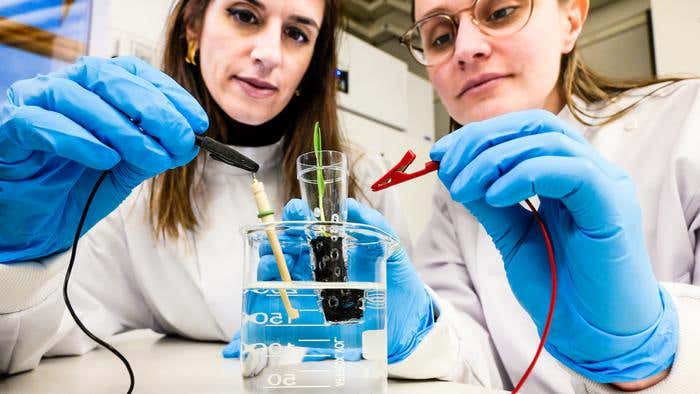Cutting-edge “eSoil” boosts barley growth by a staggering 50%
Researchers have harnessed the power of electricity to stimulate the growth of barley seedlings through soilless hydroponics.

[Dec. 28, 2023: JD Shavit, The Brighter Side of News]
Eleni Stavrinidou, associate professor, and supervisor of the study and Alexandra Sandéhn, PhD student, one of the lead authors, connect the eSoil to a low power source for stimulating plant growth. (CREDIT: Thor Balkhed)
In a groundbreaking study published in the prestigious journal PNAS, scientists from Linköping University have unveiled a remarkable innovation in the world of agriculture. These researchers have harnessed the power of electricity to stimulate the growth of barley seedlings in hydroponics, a soilless cultivation method.
The results are astonishing: barley seedlings grown in this electrically conductive "soil," aptly named eSoil, exhibited a remarkable increase in growth, up to a staggering 50% more growth in just 15 days.
The lead scientist behind this pioneering work is Eleni Stavrinidou, an associate professor at the Laboratory of Organic Electronics at Linköping University. She heads the Electronic Plants group and is a visionary in the field of sustainable agriculture.
Stavrinidou emphasized the urgency of their research, stating, "The world population is increasing, and we also have climate change. So it's clear that we won't be able to cover the food demands of the planet with only the already existing agricultural methods. But with hydroponics, we can grow food also in urban environments in very controlled settings."
Related Stories
Hydroponic cultivation, as employed in this study, eliminates the need for traditional soil, relying instead on water, nutrients, and a suitable substrate for plant roots to anchor. It operates as a closed system, enabling efficient water recirculation, ensuring each seedling receives precise nutrients, and minimizing water consumption. This nutrient recycling is impossible in conventional farming.
Furthermore, hydroponics opens up the possibility of vertical cultivation in towering structures, optimizing space utilization. While hydroponics has been predominantly used for crops like lettuce, herbs, and select vegetables, grains like barley have traditionally not been grown using this method. However, the Linköping University research has challenged this notion, demonstrating that barley seedlings can thrive in hydroponics, especially when subjected to electrical stimulation.
Eleni Stavrinidou explained the potential of their discovery, saying, "In this way, we can get seedlings to grow faster with fewer resources. We don't yet know how it actually works, which biological mechanisms are involved. What we have found is that seedlings process nitrogen more effectively, but it's not clear yet how the electrical stimulation impacts this process."
A barley seedling grows within the eSoil, an artificial electronic soil that makes seedlings grow faster. (CREDIT: Thor Balkhed)
Traditionally, hydroponics has employed mineral wool as a cultivation substrate. However, this material presents two significant drawbacks—it is non-biodegradable and produced through an energy-intensive process. In contrast, the newly developed electronic cultivation substrate, eSoil, is composed of cellulose, the most abundant biopolymer on Earth, blended with a conductive polymer known as PEDOT. While this combination is not entirely novel, its application in plant cultivation and the creation of an interface for plants represent an innovative breakthrough.
Previous studies had used high voltage to stimulate plant roots, but the eSoil developed by the Linköping researchers boasts a major advantage—extremely low energy consumption and no high voltage danger. Eleni Stavrinidou anticipates that their research will pave the way for new avenues of exploration and innovation in hydroponic cultivation.
eSoil: a 3D porous conducting scaffold for plant growth. Photograph of the eSoil and the chemical structures of its components; nanofibrillated cellulose (NFC), PEDOT:PSS, GOPS, and DMSO. (CREDIT: PNAS)
Stavrinidou underscored the potential impact of their work, stating, "We can't say that hydroponics will solve the problem of food security. But it can definitely help, particularly in areas with little arable land and harsh environmental conditions."
The significance of this research extends far beyond the confines of traditional agriculture. As the global population continues to surge and climate change disrupts traditional farming practices, innovative solutions like hydroponics and eSoil become increasingly vital. The ability to produce more food with fewer resources in controlled environments offers hope for a sustainable and secure future.
eSoil supports the growth of the root system with plants growing as well as in rockwool in hydroponics. Experimental setup for the plant growth assay in rockwool and eSoil. Pregerminated seeds are placed in rockwool or the eSoil and let to grow for 15 d in individual containers for each plant. (CREDIT: PNAS)
The eSoil developed by the Electronic Plants group at Linköping University offers a compelling vision of what the future of agriculture could be—a future where we harness the power of electricity to stimulate plant growth, reduce resource consumption, and provide a lifeline to regions struggling with food security.
As we move forward, the work of Eleni Stavrinidou and her team serves as a shining example of what is possible when science and innovation converge to address some of the most pressing issues of our time. The growth of barley seedlings in eSoil is not merely a scientific achievement; it is a beacon of hope for a more sustainable and food-secure future.
For more environmental news stories check out our Green Impact section at The Brighter Side of News.
Note: Materials provided above by The Brighter Side of News. Content may be edited for style and length.
Like these kind of feel good stories? Get the Brighter Side of News' newsletter.



